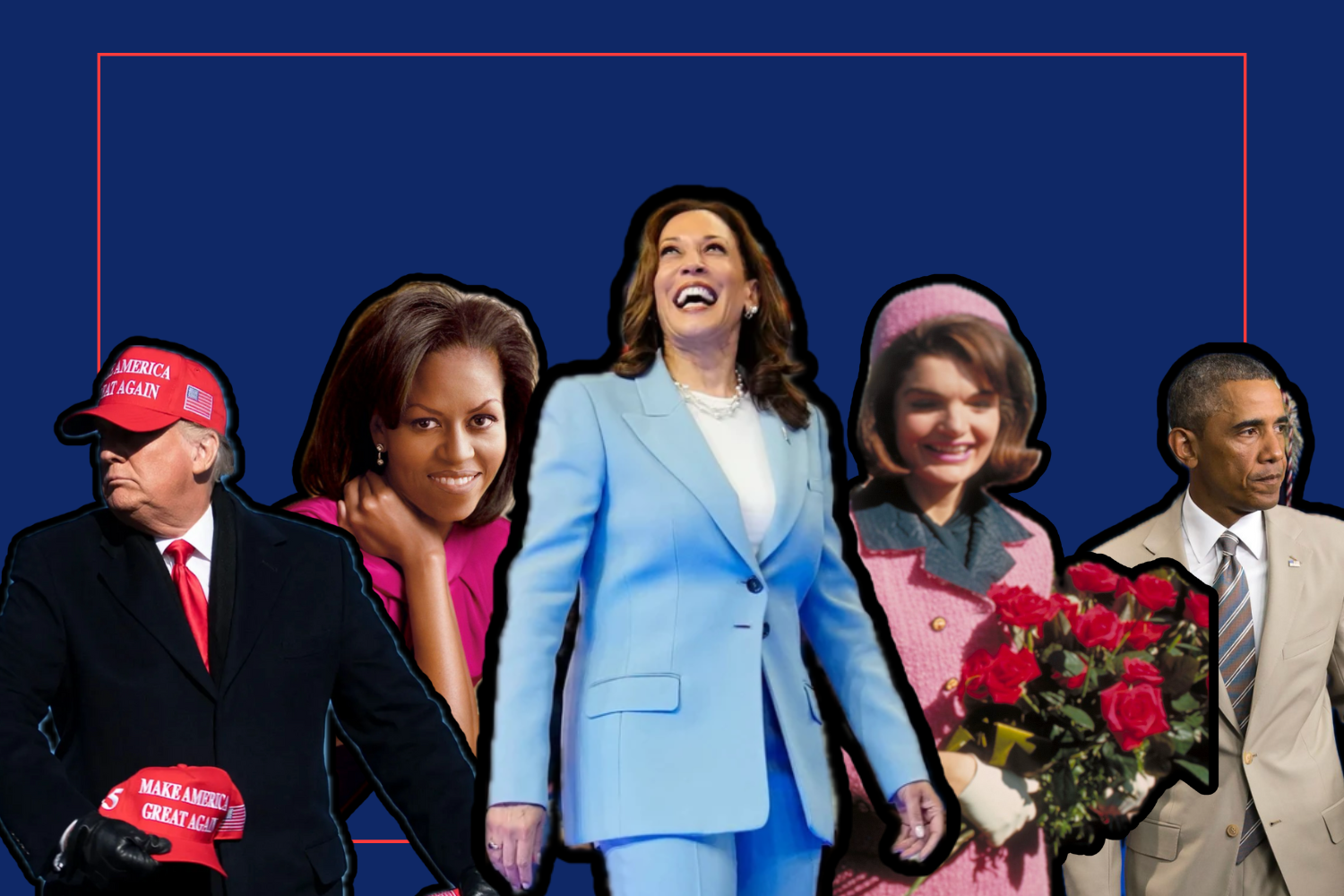Fashion, Government and Style: How Clothing Shapes American Politics
Graphic by Alexander Hernandez Gonzalez
As one of the most influential Presidential elections in the United States is about to take place, many people are feeling lost, scared and uncertain about what the future holds. When politics are mentioned, we often think of policies, extreme agendas and the flaws that politicians are prone to.
Yet, we rarely think about what political figures are wearing, why they wear it and what message they want to send with their outfit choices. From Jackie Kennedy wearing Chanel-inspired clothing to Kamala Harris wearing a slew of colorful suits, the impact of fashion on American politics is crystal clear and will not be going anywhere soon.
The use of certain fabrics, silhouettes and colors in clothing is a technique that has helped create class statuses and has existed for centuries now, including in democratic countries internationally.
For example, Queen Elizabeth I created the Sumptuary Laws that only allowed herself and her closest relatives to wear royal purple, a historically expensive and exclusive color for centuries.
When the U.S. gained its independence, George Washington wore a dark brown suit made in the new nation. Since the country was newly independent, wearing clothing that was not produced locally would go against the founding principles.
Politicians wearing sharp attire have never been favored since the country's inception because it alienates the general public. People in early America were constantly reminded that a politician who dressed well wasn't considered a leader.
For women in the political sphere, clothing allowed them to make a statement, send messages to the masses and gain respect. It’s also important to note that, regardless of their position of power, women are often questioned, belittled and judged by their stylistic choices while men, mainly white men, have the privilege of not experiencing the same treatment.
The Women’s Suffrage Movement in the 1900s, the Civil Rights Movement in the 60s and the Second Wave of Feminism in the 70s all used clothing to liberate communities, express politically-driven messages and as an act of resistance against oppressors.
As women continued to become prominent figures in American society, the media attention would solely depend on the way they presented themselves.
Jackie Kennedy, former First Lady and wife of President John F. Kennedy, is the greatest example of how her personal style became political yet allowed her personality to shine through. Deemed an “American fashion icon,” Kennedy was not afraid of wearing a pop of color to contrast JFK’s classic navy blue suits.
Kennedy knew she had the power to use clothing as a driving force to express her personality and individuality as First Lady. She collaborated with fashion designer Oleg Cassini to create French-inspired dresses, shoes, bags and the iconic strawberry-tweed suit that is now a well-renowned piece of American fashion history.
As elections continued to take place in the U.S., the two major political parties had their respective colors to represent them: blue for the Democrats and red for the Republicans. Politicians would always dress in navy blue suits, white dress shirts and a bold red or blue tie, depending on their respective party.
When the Obamas came into the White House, many looked to First Lady Michelle Obama as not just an inspiring role model, but as a fashion icon. Not only did Michelle help out many predominantly brown and Black communities to support healthy households, but she did it while showing the American public that you can express yourself through clothing.
Notably, her Vogue 2009 cover and interview with the late André Leon Talley showed that even though clothes aren’t her main priority, she has fun with her outfits and encourages women to do the same. Her subtle yet stunning monochromatic dresses make Michelle the modern American fashion icon.
Michelle Obama’s huge fashion influence transferred to her husband, then-President Barack Obama, when he sported a tan suit during a 2014 press conference on ISIS in Syria. The former President received massive backlash due to his “different” suit, which was one of the only times that a man in power’s fashion choice received mixed reactions.
As the Trumps took over office, they used fashion to respond to “Fake News” and created some of the most tone-deaf moments the country has ever seen.
From the classic red “Make America Great Again” hat that sold over 2 million units to Melania Trump’s green “I Really Don’t Care, Do U? Zara jacket that she wore when visiting undocumented children at the border, they easily contradicted their message of supporting American-made products.
Now, as Harris and Trump are battling it out to gain more votes across the nation, the use of fashion is more prominent than ever. Trump has worn a McDonald’s uniform, a garbage truck driver vest and a classic navy blue suit with a white dress shirt and red tie.
On the other hand, Harris has worn tan (to reference Obama), purple, blue, pink, gray and black suits, disrupting the false narrative that someone who dresses “sharply” isn’t fit to lead a country. She is dressing to be the next president and her confidence shines through every single time.
Across the nation, a slew of Harris and Trump-branded clothing and accessories are taking the nation over, most notably a MAGA-themed fashion show and a Willy Chavarria “Harris” branded t-shirt that will most likely be on full display on Election Day.
We can't escape the fact that fashion is inherently political, whether we like it or not. Politicians know the power of our clothing and the messages it can easily send to the masses. What we wear is a representation of us, our thoughts and our environments.
So, whatever you decide to wear today to show your support for a candidate, make sure your political gear isn’t breaking any state laws and remember that what you are wearing will always come back to politics.

